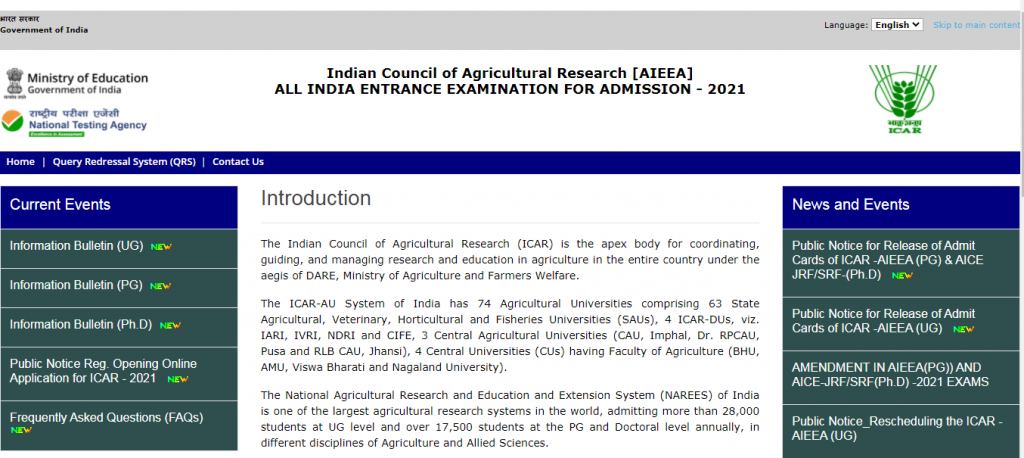ICAR AIEEA Syllabus 2021, Check AIEEA UG/PG Programmes Syllabus. ICAR AIEEA syllabus 2021 will be prescribed by the exam conducting authority. The Indian Council of Agricultural Research (ICAR) is organised by the All India Entrance Examination for Admission (AIEEA). AIEEA UG is conducted for undergraduate courses, and AIEEA PG is conducted for postgraduate classes in agriculture offered by the agriculture universities. It is a national level entrance exam, whose 15% seats of bachelor degree programmes (B.Sc ag./ B.Tech/ B.F.Sc, etc.) in Agricultural Universities (AUs) will be filled through ICAR AIEEA UG exam. In this article, candidates can check the ICAR AIEEA syllabus 2021.
To read more about the ICAR AIEEA exam, click here
ICAR AIEEA Syllabus 2021
Candidates can check the complete ICAR AIEEA syllabus for UG and PG programmes offered through the ICAR AIEEA entrance exam. The exam conducting authority will provide the syllabus for every course offered in the university. The syllabus will be prescribed differently for the UG and PG courses. Candidates can study as per the given official syllabus. Below candidates can check the ICAR AIEEA syllabus subject-wise for UG and PG courses.

ICAR AIEEA Syllabus for UG (AIEEA UG 2021) Programmes
For Physics:
Advertisement
Physical World and Measurement, Kinematics, Laws of Motion, Work, Energy and Power, Gravitation, Motion of System of Particles and Rigid Body, Properties of Bulk Matter, Thermodynamics, Behaviour of Perfect Gas and Kinetic Theory, Oscillations and Waves, Electrostatics, Current Electricity, Magnetic Effects of Current and Magnetism, Electromagnetic Induction and Alternating Currents, Electromagnetic waves, Optics, Dual Nature of Matter and Radiation, Atoms and Nuclei, Electronic Devices and Communication Systems.
For Chemistry:
Some Basic Concepts of Chemistry, Solid State, Solutions, Structure of Atom, Classification of Elements and Periodicity in Properties, Chemical Bonding and Molecular Structure, States of Matter: Gases and Liquids, Thermodynamics, Equilibrium, Redox Reactions, Hydrogen, s-Block Elements (Alkali and Alkaline earth metals): Group 1 and Group 2 elements, Preparation and properties of some essential compounds, Some p-Block Elements: General Introduction to p-Block Elements: Group 13 elements, Group 14 elements Organic
Chemistry: Some Basic Principles and Techniques, Hydrocarbons: Classification of hydrocarbons, Electrochemistry, Chemical Kinetics, Surface Chemistry, General Principles and Processes of Isolation of Elements, p-Block Elements: Group 15 elements, Group 16 elements, Group 17 elements, Group 18 elements, d and f Block Elements, Coordination Compounds, Haloalkanes and Haloarenes, Alcohols, Phenols and Ethers, Aldehydes, Ketones and Carboxylic Acids, Organic compounds containing Nitrogen, Biomolecules, Polymers, Environmental Chemistry and Chemistry in Everyday Life.
For Biology (Botany and Zoology):
The Living World, Unit of Life, Diversity of Life, Organisms and Environment, Multicellularity: Structure and Function-Plant Life, Multicellularity: Structure and Function-Animal Life, Continuity of Life, Origin and Evolution of Life and Application of Biology.
For Mathematics:
Sets and Functions, Algebra, Coordinate Geometry, Calculus, Vectors and Three-Dimensional Geometry, Linear Programming, Mathematical Reasoning, Statistics and Probability, Statics and Dynamics.
For Agriculture:
Agrometeorology, Genetics and Plant Breeding, Biochemistry and Microbiology, Livestock Production, Crop Production and Horticulture.
Syllabus for PG Programmes:
For Agri-Bussiness Management:
Agri-Business Management (MBA) and Agricultural Marketing and Cooperation (M.Sc.).
For Animal Sciences:
Animal Husbandry/Dairy Sci, Animal Genetics and Breeding, Animal Nutrition, Very./Animal Physiology, Livestock Production Management, Livestock Products Technology, Poultry Science, Very. and Animal Husbandry Extension, Livestock/ Veterinary/ Animal Husbandry Economics and Bio-Statistics.
For Veterinary Science:
Veterinary Anatomy/ Veterinary Anatomy and Histology, Veterinary Gynaecology and Obstetrics/Ani. Reproduction, Very. Medicine (Clinical/Preventive), Veterinary Parasitology, Veterinary Pharmacology and Toxicology, Veterinary Pathology, Wildlife Science/ Wildlife Health Mgt., Very.Virology, Very. Immunology, Veterinary Microbiology and Immunology/Bacteriology, Veterinary Surgery and Radiology, Veterinary Public Health and Epidemiology/Very. Public Health/Very.Epidemiology/ Very. Epidemiology and Preventive Medicine.
For Agricultural Engineering and Technology:
Soil and Water Conservation Engg./Soil and Water Engg., Irrigation Drainage Engg,/Irrigation Water Mgmt.Engg., Post Harvest Technology/ Processing and FoodEngg., Farm Machinery and Power Engg. And Renewable Energy Engg.
For Horticulture:
Horticulture, Vegetable Crops or Sci. / Olericulture, 8.3: Pomology/ Fruit Sci., Fruit Sci. and Horticulture Technology, Post-Harvest Technology of Horticultural Crops, Floriculture and Landscaping Architecture, Plantation Spices, Medicinal and Aromatic Crops.
For Physical Science:
Agricultural / Agro. Meteorology, Soil Science and Agricultural Chemistry/ Soil Conservation and Water Management/ SWC/ Irrigation and Water Management, Agricultural Physics, Agricultural Chemicals and Environmental Science
For Plant Sciences:
Plant Breeding and Genetics, Plant Pathology, Agricultural Microbiology/Microbiology, Seed Science and Technology and Plant Genetic Resources.
For Plant Biotechnology:
Plant Biochemistry/ Bio. Chem., Plant Biotechnology and Molecular Biology/Biotechnology and Plant /Crop Physiology.
